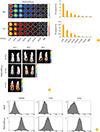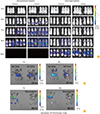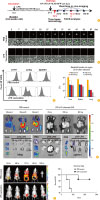Construction of a plasmid with dual reporter and generation of reporter expressing F. tularensis
Plasmids containing fluorescence and bioluminescence reporter genes (pKK214-GFP-Lux) with constitutive bacterioferritin (Bfr) promoter was established for transforming
FtLVS (
Fig. 1A). Dual reporter expressing
FtLVS was successfully generated (
FtLVS-GFP-Lux) (
Fig. 1B). To increase the imaging sensitivity, we introduced Bfr promoter to pKK214 vector. We compared the activity between pGloEL promoter and putative Bfr promoter in pKK214s for dual reporter expression. Both fluorescence and bioluminescence signals from transformed cells with plasmids under the control of Bfr promoter were higher than that of the cells with pGloEL, the original promoter of pKK214-GFP (
Fig. 1C). Therefore, we used
FtLVS-GFP-Lux with Bfr promoter to investigate spatiotemporal tracing of
F. tularensis in the mouse model.
Next we analyzed the fluorescence and bioluminescence intensity from
FtLVS-GFP-Lux to quantify the number of
F. tularensis. Both fluorescence and bioluminescence signals from
FtLVS-GFP-Lux increased with the number of
F. tularensis represented by CFU (
Fig. 2A). In addition, signals from
FtLVS-GFP-Lux infected mouse also increased with the number of
F. tularensis at the same time point after infection (
Fig. 2B). We also monitored distribution of
F. tularensis in the organ of infected mouse. Though GFP signals from the injected
FtLVS-GFP-Lux (intravenously, 10
2 CFU/mouse) were not observed in the whole body of a mouse at 24 hours after infection (
Fig. 2A), GFP signals were observed in the thymus, lung, liver, spleen and intestine at 24 hours after infection when we open the body of an infected mouse. For flow cytometry, we isolated cells from each
F. tularensis (
FtLVS or
FtLVS-GFP-Lux) infected organs. When we compared the GFP signals from
FtLVS or
FtLVS-GFP-Lux infected organs, we could observe strong GFP signals from
FtLVS-GFP-Lux infected organs such as liver, lung and spleen (
Fig. 2C).
For spatio-temporal molecular imaging
F. tularensis, we monitored
FtLVS-GFP-Lux (10
2 CFU/mouse) infected mouse with various infection route such as intra-peritoneal, and intra-nasal injection (
Fig. 3A). We analyzed bioluminescence signals from infected mice for a week (168 hours) with noninvasive imaging. Though bio-distribution of
FtLVS-GFP-Lux in the infected mice with all injection route were similar, proliferation of
FtLVS-GFP-Lux in the intra-nasal injected mice were slower than that in the intra-peritoneal injected mice. In nasally injected mice, lux signals were observed in the lung first, and the signals spread throughout body later. In peritoneally injected mice, lux signals observed in the injection site and then spread to spleen, liver, and lung.
When we compared fluorescence and bioluminescence imaging in the organ of infected mouse, bioluminescence signals were more sensitive than fluorescence signals (
Fig. 3B). For fluorescence imaging, external excitation light source is required and the tissue penetration depth of each light source is different. However, our
FtLVS-GFP-Lux contains LuxCDE as well as LuxAB (luciferase) and does not require the external light source. This may relate with lower sensitivity of GFP fluorescence compared to Lux bioluminescence.
Since we use live vaccine strain, we tested the vaccination effect of
FtLVS by monitoring
FtLVS-GFP-Lux in the infected mice.
FtLVS (1×10
3 CFU) were vaccinated to mice, challenged with
FtLVS-GFP-LUX at 3 weeks after vaccination, and monitored the proliferation of
FtLVS-GFP-LUX by fluorescence and bioluminescence. We isolated the organs from infected mice with or without vaccination, and monitored imaging signals (
Fig. 3C). At 96 hours after challenge of
FtLVS-GFP-LUX, vaccinated mouse clearly showed less fluorescence and bioluminescence signals in the target organ indicating less proliferation of
FtLVS-GFP-LUX.
FtLVS-GFP-Lux imaging after LPS vaccination
For evaluation of our imaging analysis as an efficient monitoring system of vaccine development, we tested the vaccine efficacy of LPS for
F. tularensis infection. General protection efficacy of LPS from
F. tularensis was reported [
1112], but the detailed process of pathogenesis or vaccination was not fully investigated. With advantage of our dual-labeled
F. tularensis monitoring system using
FtLVS-GFP-Lux, we investigated the process of
in vivo pathogenesis in mice with or without
F. tularensis-LPS vaccination (
Fig. 4A). Fluorescent signals from GFP from
FtLVS-GFP-Lux were analyzed for time-lapse single cell imaging (
Fig. 4B) and flow cytometry (
Fig. 4C). Bioluminescent signals from Lux of
FtLVS-GFP-Lux were analyzed for non-invasiveness pathogen tracing (
Fig. 4E, F).
For visualizing replication pattern of
F. tularensis, splenocytes from non-vaccinated and LPS (20 ng/mouse) vaccinated mice were subjected to time-lapse fluorescent microscopy.
FtLVS-GFP-Lux was rapidly replicated within splenocyte of non-vaccinated control mouse throughout observation, while GFP-expressing
FtLVS-GFP-Lux cannot be replicated and disappeared within splenocytes of LPS vaccinated mice (
Fig. 4B). Then, we analyzed more detailed event of
F. tularensis infection using fluorescent signals from
FtLVS-GFP-Lux in cellular level by measuring the portion of infected cell in each target organ using flow cytometric analysis. At 72 hours after infection, GFP signals were observed in the cells from liver, spleen and lung of control mouse indicating
FtLVS-GFP-Lux infection, while GFP signals were not observed in the cells from LPS vaccinated mice (
Fig. 4C).
To decide the optimized vaccination amount of LPS, bacterial burden was also calculated by counting the infected cells in the target organ of mice with or without LPS vaccination. LPS vaccination clearly reduced
F. tularensis infection and higher amount (500 ng) of LPS showed more effective vaccination results (
Fig. 4D). We also monitored the proliferation of challenged
FtLVS-GFP-Lux in the organ of infected mouse with different amount of LPS vaccination (
Fig. 4E). LPS vaccinated mice showed lower bioluminescence signals indicating less
FtLVS-GFP-Lux proliferation.
In the whole body imaging,
FtLVS-GFP-Lux in the control non vaccinated mouse was multiplied at infection site (peritoneal cavity for intraperitoneal injection) first and propagated to other sites 24 hours after infection (
Fig. 4F, upper panel). Liver is the first target site of propagation and, lung and spleen is also revealed as target organ of bacterial invasion. On the other hand, only limited signals of
FtLVS-GFP-Lux from LPS vaccinated mouse were detected at infection site (
Fig. 4F, lower panel). LPS vaccination also clearly increased survival rate of infected mouse (
Fig. 4G).
Our results successfully demonstrated the efficacy of F. tularensis-LPS vaccination to the F. tularensis infection by using various imaging methods at the cellular, organ, and whole body level. These indicate that our FtLVS-GFP-Lux system can be very useful for the investigation of F. tularensis pathogenesis with various analysis methods such as histology, flow-cytometry, in vitro and in vivo molecular imaging.








 PDF
PDF ePub
ePub Citation
Citation Print
Print



 XML Download
XML Download